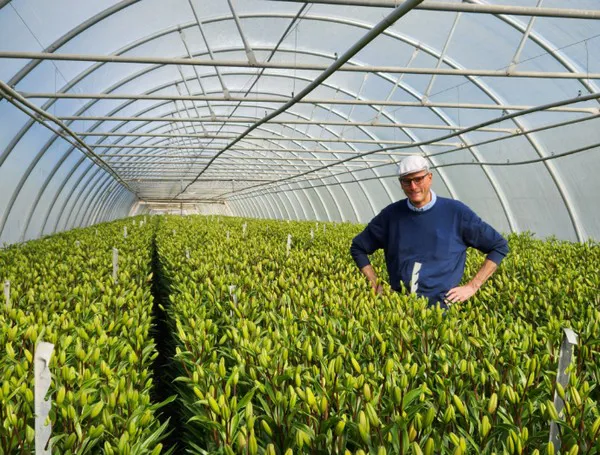Longiflorum Asiatic (LA) Hybrid lilies are one of the workhorses of the cut flower industry. Going back a decade or two, it was just Asiatics and Oriental varieties that dominated the market, but cross-breeding the Longiflorum lilies (commonly known as Easter lilies) with Asiatics created a sturdy lily, available in the traditional colors of Asiatics, such as pink, yellow, peach, orange, white, red and even some bi-colors. Featuring no scent and a very long vase life, LA Hybrids can be found in bouquets and bunches across the United States.

Lane de Vries
But this is only half the story.
Not all LA Hybrids are created equal. To highlight this difference, Sun Valley has been branding LA Hybrids as 'Royal Lilies' because the process for selecting and growing LA Hybrids creates a superior lily.
The first factor is bulb selection. Lane DeVries travels to Holland to select the premier bulbs. These varieties include modern classics such as the Diamond series; featuring Yellow Diamond, Party Diamond, and Indian Diamond. Plus, several other standouts, such as Bach, Sunset, Zanella, Tenno, Lentella, Hinault, and Menorca. Together you have the basis of our Royal Lily program.
For all of these varieties, only the largest bulbs are used, which leads to the largest bloom and best vase life in the proper growing conditions. Bulbs are mostly 12-14 centimeters and bursting with kinetic energy.
So, "growing conditions"?
Sun Valley grows Royal lilies between their two locations, based on the best-growing conditions. "Traditionally in the summer, and fall, we grow in the cool climate of Humboldt County in northern coastal California, and in the winter and spring, production moves to the Oxnard Plain just south of Ventura, in Southern California," the Sun Valley explains.
"The key here, is that we are growing the lilies at sea level with moderate temperatures. Our proximity to the Pacific Ocean creates a steady temperature base, without spikes in hot or cold. This coastal atmosphere is a better-growing environment than growing at high altitude."
The next factor is growing expertise. The agronomists at Sun Valley are very experienced in the industry. Growing flowers requires a constant eye on the crop. Being able to adjust the flaps on the hoop houses, add light, or protect from frost damage, is no easy task. The Sun Valley team has been as it is for decades, so this wealth of experience has led to an actionable knowledge base, that brings the crop in right on time. We still have pink Royals for Valentine's, hint hint!
"When buying lilies there is a story behind the bloom you see in the store or at your wholesale house. To get the best results, you work with the highest quality flowers. So be sure to ask for Sun Valley Royal Lilies next time you think you want an LA hybrid. The difference will astound you!"
For more information:
Bill Prescott The Sun Valley Group
The Sun Valley Group
3160 Upper Bay Road
Arcata, CA 95521-9690
Tel.: 707-825-580
bprescott@tsvg.com
www.thesunvalleygroup.com
